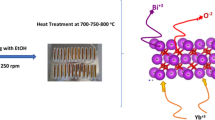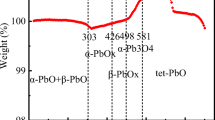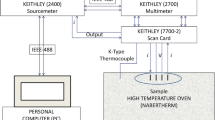Abstract
Cubic-stabilized ((DyO1.5) x –(WO3) y –(BiO1.5)1 − x − y ) electrolytes (DWSB) with much higher conductivity than (ErO1.5)0.2(BiO1.5)0.8, 20ESB, were developed through a double-doping strategy. (DyO1.5)0.08–(WO3)0.04–(BiO1.5)0.88, 8D4WSB, is the highest conductivity composition but underwent the greatest conductivity degradation at 500 °C due to its low total dopant concentration. The effect of dopant composition on conductivity behavior with time at 500 °C demonstrates that there is a trade-off between initial conductivity and long-term stability at this temperature. Therefore, it is necessary to find an optimal total and relative concentration of dopants to provide the enhanced long-term stability needed to make this DWSB electrolyte system feasible for 500 °C operation. To this end, it was found that (DyO1.5)0.25–(WO3)0.05–(BiO1.5)0.70, 25D5WSB, maintained a conductivity of 0.0068 S/cm without appreciable degradation after annealing at 500 °C for 500 h. Moreover, since bismuth oxide-based electrolytes do not exhibit any grain boundary impedance, the total conductivity of 25D5WSB is significantly higher than that of alternate electrolytes (e.g., GDC: Gd0.1Ce0.9O1.95) at this temperature.








Similar content being viewed by others
References
Azad AM, Larose S, Akbar SA (1994) Bismuth oxide-based solid electrolytes for fuel-cells. J Mater Sci 29:4135–4151
Steele BCH (2001) Material science and engineering: the enabling technology for the commercialisation of fuel cell systems. J Mater Sci 36:1053–1068
Yamamoto O (2000) Solid oxide fuel cells: fundamental aspects and prospects. Electrochim Acta 45:2423–2435
Minh NQ (1993) Ceramic fuel-cells. J Am Ceram Soc 76:563–588
Zheng K, Steele BCH, Sahibzada M, Metcalfe IS (1996) Solid oxide fuel cells based on Ce(Gd)O2 − x electrolytes. Solid State Ion 86–88:1241–1244
Verkerk MJ, Keizer K, Burggraaf AJ (1980) High oxygen ion conduction in sintered oxides of the Bi2O3–Er2O3 system. J Appl Electrochem 10:81–90
Jung DW, Duncan KL, Wachsman ED (2009) Effect of total dopant concentration and dopant ratio on conductivity of (DyO1.5) x –(WO3) y –(BiO1.5)1 − x − y . Acta Mater 58:355–363
Wachsman ED, Ball GR, Jiang N, Stevenson DA (1992) Structural and defect studies in solid oxide electrolytes. Solid State Ion 52:213–218
Ahn JS, Pergolesi D, Camaratta MA, Yoon H, Lee BW, Lee KT, Jung DW, Traversa E, Wachsman ED (2009) High-performance bilayered electrolyte intermediate temperature solid oxide fuel cells. Electrochem Commun 11:1504–1507
Park JY, Yoon H, Wachsman ED (2005) Fabrication and characterization of high-conductivity bilayer electrolytes for intermediate-temperature solid oxide fuel cells. J Am Ceram Soc 88:2402–2408
Jiang N, Wachsman ED (1999) Structural stability and conductivity of phase-stabilized cubic bismuth oxides. J Am Ceram Soc 82:3057–3064
Fung KZ, Chen J, Virkar AV (1993) Effect of aliovalent dopants on the kinetics of phase-transformation and ordering in Re2O3–Bi2O3 (Re=Yb, Er, Y, or Dy) solid-solutions. J Am Ceram Soc 76:2403–2418
Jung D, Duncan KL, Camaratta MA, Lee K, Nino JC, Wachsman ED (2009) Effect of annealing temperature and dopant concentration on conductivity behavior in (DyO1.5) x –(WO3) y –(BiO1.5)1 − x − y . J Am Ceram Soc (in press)
Nelson JB, Riley DP (1945) An experimental investigation of extrapolation methods in the derivation of accurate unit-cell dimensions of crystals. Proc Phys Soc 57:160–177
Duran P, Jurado JR, Moure C, Valverde N, Steele BCH (1987) High oxygen ion conduction in some Bi2O3–Y2O3(Er2O3) solid-solutions. Mater Chem Phys 18:287–294
Verkerk MJ, Burggraaf AJ (1983) Oxygen-transfer on substituted ZrO2, Bi2O3, and CeO2 electrolytes with platinum-electrodes. II. A.C. impedance study. J Electrochem Soc 130:78–84
Wang LS, Barnett SA (1992) Deposition and properties of yttria-stabilized Bi2O3 thin-films using reactive direct-current magnetron cosputtering. J Electrochem Soc 139:2567–2572
Macdonald JR (1987) Impedance spectroscopy. Wiley, New York
Zhang TS, Ma J, Chan SH, Hing P, Kilner JA (2004) Intermediate-temperature ionic conductivity of ceria-based solid solutions as a function of gadolinia and silica contents. Solid State Sci 6:565–572
Omar S, Wachsman ED, Nino JC (2006) A co-doping approach towards enhanced ionic conductivity in fluorite-based electrolytes. Solid State Ion 177:3199–3203
Omar S, Wachsman ED, Nino JC (2008) Higher conductivity Sm3+ and Nd3+ co-doped ceria-based electrolyte materials. Solid State Ion 178:1890–1897
Yashima M, Ishimura D (2003) Crystal structure and disorder of the fast oxide-ion conductor cubic Bi2O3. Chem Phys Lett 378:395–399
Ling CD, Withers RL, Thompson JG, Schmid S (1999) Structures of Bi14WO24 and Bi14MoO24 from neutron powder diffraction data. Acta Crystallogr B 55:306–312
Knight KS (1992) The crystal-structure of russellite—a redetermination using neutron powder diffraction of synthetic Bi2WO6. Mineral Mag 56:399–409
Wachsman ED, Boyapati S, Jiang N (2001) Effect of dopant polarizability on oxygen sublattice order in phase-stabilized cubic bismuth oxides. Ionics 7:1–6
Wachsman ED (2004) Effect of oxygen sublattice order on conductivity in highly defective fluorite oxides. J Eur Ceram Soc 24:1281–1285
Boyapati S, Wachsman ED, Chakoumakos BC (2001) Neutron diffraction study of occupancy and positional order of oxygen ions in phase stabilized cubic bismuth oxides. Solid State Ion 138:293–304
Wachsman ED, Boyapati S, Kaufman MJ, Jiang N (2000) Modeling of ordered structures of phase-stabilized cubic bismuth oxides. J Am Ceram Soc 83:1964–1968
Drache M, Obbade S, Wignacourt JP, Conflant P (1999) Structural and conductivity properties of Bi0.775Ln0.225O1.5 oxide conductors (Ln=La, Pr, Nd, Sm, Eu, Gd, Tb, Dy) with rhombohedral Bi–Sr–O type. J Solid State Chem 142:349–359
Verkerk MJ, Burggraaf AJ (1981) High oxygen ion conduction in sintered oxides of the Bi2O3–Dy2O3 system. J Electrochem Soc 128:75–82
Acknowledgments
This study was financially supported by the National Aeronautics and Space Administration under contract NAG3-2930 and the Florida Institute for Sustainable Energy. The authors would like to thank the Major Analytical Instrumentation Center at University of Florida.
Author information
Authors and Affiliations
Corresponding author
Rights and permissions
About this article
Cite this article
Jung, D.W., Nino, J.C., Duncan, K.L. et al. Enhanced long-term stability of bismuth oxide-based electrolytes for operation at 500 °C. Ionics 16, 97–103 (2010). https://doi.org/10.1007/s11581-009-0402-9
Received:
Revised:
Accepted:
Published:
Issue Date:
DOI: https://doi.org/10.1007/s11581-009-0402-9




